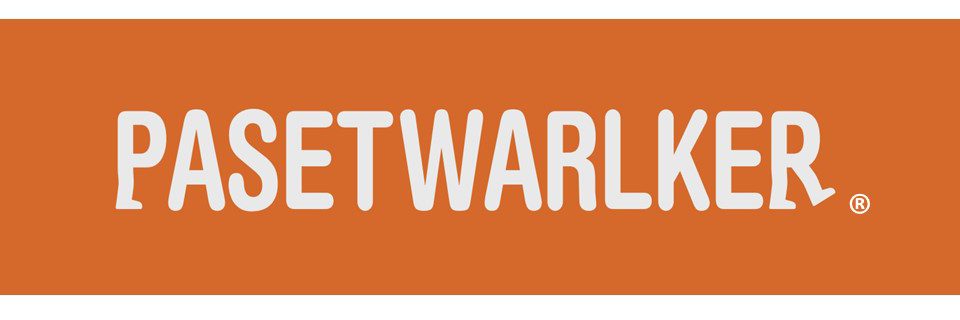◆Critical Issues to Avoid in the Hospital Ward
Have you ever experienced a fall incident or a near-miss in the hospital ward?
When a patient actually falls, especially if it results in a fracture, their quality of life (QOL) can decline drastically.
It may lead to an extended hospital stay, and for elderly patients, even after recovery, limited mobility can make it difficult to return to their previous way of life.
There is also a risk of subsequent falls, and such incidents can undermine the family’s trust in the hospital.
For clinical staff—who are dedicated to supporting patient recovery—such events often leave lingering regrets like,
“If only I had been watching at that moment…”
Falls in the hospital ward impact not only the patients, but also their families, healthcare providers, and the hospital itself.
They are not someone else’s problem—they matter to all of us.
To help prevent such incidents—especially for post-operative patients with unsteady gait and multiple medical devices—
we offer the PASETWALKER, an assistive mobilization device designed to support safe and secure ambulation.
We have also received positive feedback noting its usefulness from a patient safety perspective.
◆The Benefits of Using the PASETWALKER
Standard Post-Surgery Walking (通常の術後歩行)
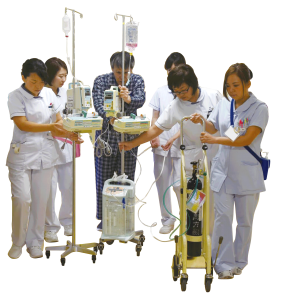
To ensure safe and reliable ambulation immediately after surgery, it typically requires the use of several medical devices, the attention of multiple healthcare providers, and continuous focus on the patient’s condition.
However, IV poles are originally designed for stationary intravenous infusions, not for supporting ambulation. When patients attempt to walk while holding onto an IV pole, several issues arise:
- The pole obstructs their forward view
- The wide base can interfere with foot movement and cause tripping
- The small wheels catch easily on minor surface irregularities
- The single-hand grip is not ideal for weight-bearing or balance
- The high center of gravity makes the pole unstable
Additionally, in many clinical settings, suction devices are often tied to the pole with strings or cords, further increasing the risk of instability. To ensure safe ambulation, staff assistance is often required to manage the equipment properly.
Improvements Enabled by the PASETWALKER (パセットウォーカーで起こる変化)
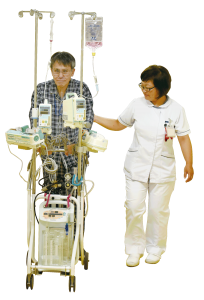
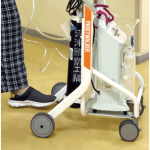
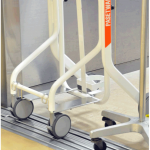
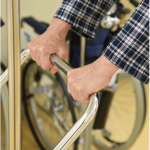
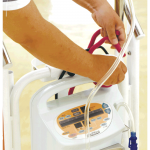
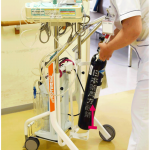
The Pasetwalker, a post-surgical ambulation support device, is specifically designed to ensure safer and more confident early mobilization after surgery.
- The IV pole is positioned away from the patient’s direct line of sight, allowing a clear forward view
- The base design provides ample space for natural foot movement
- Large wheels make it easy to overcome small steps or uneven surfaces
- Dual handgrips offer better support and balance for the patient
- The device has a low center of gravity for increased stability
Postoperative ambulation often requires significant preparation and cleanup effort for healthcare providers.
To address this, the Pasetwalker is designed to easily accommodate both suction devices and oxygen cylinders, reducing the workload for staff.
Due to these unique features and its usefulness during early mobilization, the Pasetwalker has been featured in official publications by the Japan Society of Early Mobilization.
◆Featured in Professional Books
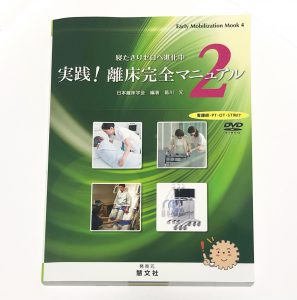

Japan Early Mobilization Society – Practical Complete Manual for Early Mobilization 2, First Edition: December 11, 2018
(The Assistive Early Mobilization Device “Pasetwalker” is featured on page 86.)
◆User Feedback
-
I became more attentive to patients and was able to better assist them during ambulation than before.
-
It was easier to move the ME equipment when placed on the Pasetto Walker rather than on an IV stand.
-
Since multiple medical devices can be placed on a single unit, I believe it encouraged patients to get out of bed.
It was also helpful from an operational standpoint, as it reduced the need for multiple staff to assist. -
I believe this device plays a major role in supporting patient independence.
-
Patients could move safely without feeling anxious, even when encountering steps or uneven surfaces.
-
The colorful securing tools were cute and cheerful.
-
It was stable and could be used like a rollator (silver walker).
-
I appreciated that it didn’t require constant hands-on attention from nursing staff.
-
Its stability made it easier to encourage early mobilization.
-
I could use it with patients without any concern.
-
There had been safety concerns about patients walking with ME equipment placed on IV stands, but the Pasetto Walker provided a solution from a medical safety perspective.
◆Impact of Work Efficiency Enhancements
Clinical Case
Number of Beds: 480 Number of Full-Time Nurses: 340 Usage Context: Ambulation of patients after pleural effusion drainage
The device allows for quick setup and consolidated mounting of equipment. Its stable design enables safe walking with only one staff member accompanying the patient, resulting in a reduction of approximately 10 minutes of nursing work per use.
Calculation:
10 minutes × 10 times/day × 5 days/week × 4 weeks/month × 12 months/year = 24,000 minutes/year = 400 hours/year
This translates to an annual labor cost saving of ¥1,093,750 ≒ $7,050 USD, based on official statistics.
(Based on data from the 2017 National Personnel Authority Statistical Report)
◆Options Available
i-bou: Simple Medical Fastener
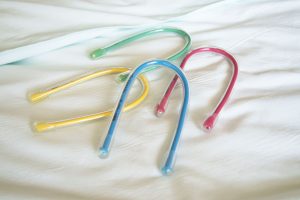

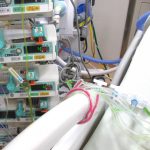
This versatile product can be used to bundle cords and tubes, or to hang various items.
Unlike improvised solutions using string or Velcro, i-bou can be disinfected with alcohol wipes, allowing for secure fastening while supporting infection control practices.
→ Go to product page
Holder for Chest Drainage Bag
You can attach two chest drain bags to the holder.
Once the holder is installed, simply insert the bags—no extra effort required.
(In the example shown, only one bag is attached.)
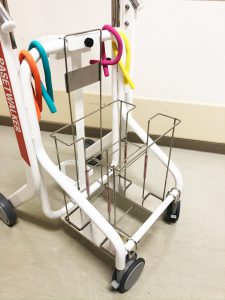
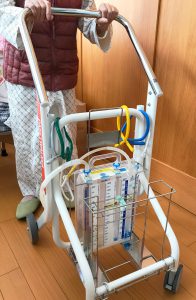
◆Usage Guide Video (Japanese)
(1m33s)
(1m9s)
(1m15s)
(1m2s)
(29s)
◆Q & A
Q. Can the handle height be adjusted?
A. The handle on the Pasetto Walker (hereafter referred to as PW) is fixed to ensure the strength necessary for enhanced stability and safety during walking—its most critical function. The handle height has been carefully designed to suit the majority of users. In fact, it is the same height commonly used for supermarket shopping carts.
Q. Can the device be made smaller to fit better beside beds in shared rooms?
A. The size of the device is essential for ensuring stability. PW is designed to be the minimum size that still guarantees both walking stability and secure equipment mounting—approximately the size of a standard bedside cabinet.
Q. Can it only be used with the Mera Sucuum (low-pressure continuous suction device)?
A. While the PW is indeed designed for ease of use with the Mera Sucuum, it can also accommodate a variety of other devices commonly used during early mobilization, including oxygen cylinders (with a dedicated holder), infusion pumps (via pipe attachments), syringe pumps (via pipe attachments), and chest drain bags (new optional accessory).
Q. Can the caster locks or brakes be operated from the handle area?
A. We encourage the assisting healthcare provider to operate the front-wheel locks directly. Many medical professionals have told us that warm, attentive support is vital for a patient’s recovery, and that seeing their patients improve is a source of motivation in their work.
With that in mind, PW was designed for post-operative patients walking with one caring staff member alongside them.
◆搭載物対応表

◆A Safer Path to Recovery: The Story Behind the PASET WALKER
This is the script I used for my presentation at the 9th Asia-Pacific Conference on Weaning and Early Mobilization in Critically ill patients.
P.S.
In these challenging times, I know that healthcare professionals are working tirelessly every day with extraordinary dedication.
The development of the Pasetto Walker began when my beloved aunt was hospitalized.
Even now, someone’s loved one is in the hospital, and I am filled with deep gratitude toward all medical professionals.
It is my sincere hope that the Pasetto Walker can be of help to both patients and the healthcare workers who care for them.
Developer of the PASETWALKER – Assistive Early Mobilization Device
Hisatoshi Watanabe
Representative, Healthcare Division, Numazu Kikou Co., Ltd.


